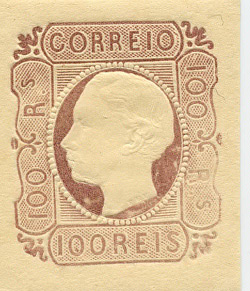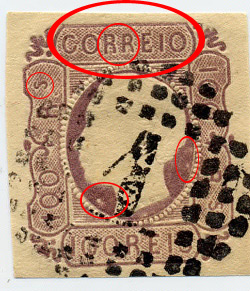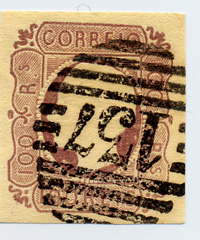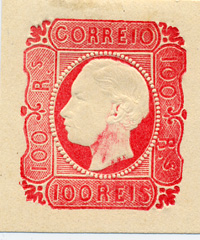 |  |  |
100
Reis D.Luis (AFINSA 18)- O |
A
|
B
|
 |
 |
Top: (A and B): two examples of the forgery, one of them cancelled, Acima: (A e B): dois exemplos do falso, um dos quais carimbado. Left: (C) another cancelled forgery; (D) a print proof with the same die. Esquerda: (C) outra falsificação carimbada e (D) uma prova batida a vermelho com o mesmo cunho da falsificação. |
|
C
|
D
|
DISTINGUISHING CHARACTERISTICS OF THE FORGERY:
-In the forgery the first "R" in "CORREIO" has a leg noticeably longer than the corresponding leg of the second "R". The embossed frame around "CORREIO" is thinner than in the genuine stamp and, because of it, the number of background losangles under and over the characters is higher in the forgery. The upper bar of the frame that includes the king's head is continuous in the genuine, but interrupted by the oval of pearls in the forgery (compare both images above).
The "S" in the left "100R.s" script is differently shaped and in the forgered stamp there are recurring white blotchy areas in the oval (at least one of the following: under the chin; and/or to the right of the lower head and neck; and/or under the neck)- see images A and B and C above.
Often offered as a reprint (1905 or 1928- in this last case prompted by the darker colour) of which it can easily be told apart because all reprints were printed from the original die. Usually found cancelled "1", "12" or "137". Supposed proofs of this stamp are often (too often, actually) offered in auctions. These have in common an ink spread over the neck, caused by an improper inking of the die. Comparing those proofs with the forgery it is apparent that both were printed from the same die. This does not mean that the proofs have been printed by the same hand or that they are not genuine- read the text below on the origin of the forgery.
CARACTERÍSTICAS DISTINTIVAS DO FALSO:
-No falso, o primeiro "R" de "CORREIO" tem a primeira perna mais longa do que a correspondente do segundo "R"; a cartela em relevo branco que rodeia "CORREIO" é mais fina no falso e em consequência o número de losangos do fundo sob e sobre as letras é superior no falso (comparar as imagens acima).
O "S" do dístico "100 R.s" do lado esquerdo da efígie, tem uma forma diferente. No falso veem-se zonas esbranquiçadas no interior da elipse, provocadas por concavidades do cunho, ocorrendo em uma ou mais das seguintes posições: sob o queixo da efígie; atrás do pescoço; sob o busto.
É por vezes vendido como reimpressão de 1905 ou de 1928 das quais se distingue facilmente porque todas as reimpressões foram batidas com o cunho original. As provas deste selo, que aparecem frequentemente em leilões, foram batidas com o mesmo cunho que imprime os falsos. Isto não quer dizer que tenham sido impressas pela mesma mão. Ver o texto abaixo sobre a origem da falsificação.
ORIGEM: Todos os selos autênticos de 100 Reis, bem como as reimpressões, foram impressos a partir de um único cunho. No entanto deve ter sido produzido um segundo cunho na Casa da Moeda, provavelmente ainda no séc. XIX, que acabou transviado e é com esse cunho que se imprime este falso. O mesmo cunho imprimiu um conjunto de provas em várias cores cuja autenticidade se desconhece. Circula a história de que haveria a intenção de imprimir sobrescritos selados e de que as provas teriam sido batidas para esse fim. Se assim foi não se compreende a profusão de provas, todas com o mesmo erro de tintagem que poderia ser facilmente corrigido pela Casa da Moeda. Existe uma razão mais plausível para a produção de um segundo cunho mas fosse qual fosse a origem, o cunho foi subtraído- provavelmente por quem também desviou o cunho do 120Reis Fita Curva que imprime o "falso italiano"- e imprime actualmente esta falsificação.
ORIGIN: The printing die used for this forgery was manufactured from the Portuguese master die for this value, as unquestionably demonstrated a microscopic comparison of genuine stamps with the forgery. The die was subtracted from the Portuguese Mint at an unknown date. The same die was used to print color proofs, the authenticity of which is unknown. These are said to be period prints preparatory to a stamped envelope that was never produced. If such an issue was ever considered, it may have been the reason for the manufacure of a second die. Yet the fact that they are common and all share the same rather basic defect (an inking of the neck) gives food for thought...
Bibliography:
Vieira, Armando "Selos Classicos de Relevo de Portugal"